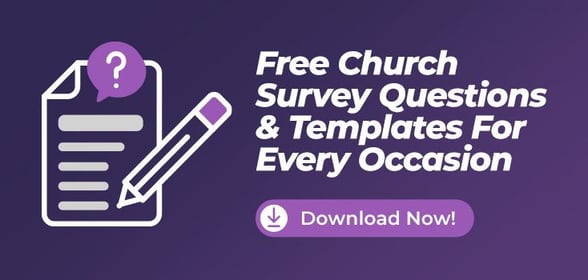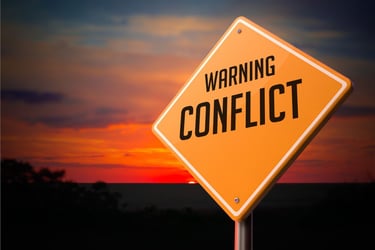
Your emails could fill your pews, increase donations and build a stronger church community, but only if people read them. The problem? Most church email marketing falls flat because it doesn’t tap into the right emotional triggers.
If you want to know how to write better church emails, you need to craft messages that spark curiosity, highlight a clear pain point and provide a compelling reason to act. In this guide, we’ll show you a step-by-step email funnel that turns readers into engaged, active members of your church.
Table of Contents
- Developing a Comprehensive Church Email Marketing Strategy
- Building and Maintaining a High-Quality Church Email List
- Leveraging Email Marketing Tools and Platforms for Churches
- Crafting Engaging and Relevant Church Email Content
- Monitoring Performance and Optimizing Church Email Campaigns
- Ensuring Compliance and Adhering to Best Practices in Church Emails
- Personalizing Church Emails for Enhanced Congregation Engagement
- Simplifying Design for Authentic Church Email Communication
- Defining Clear Objectives for Each Church Email
- Maintaining Concise and Relevant Content in Church Emails
- Encouraging Engagement Through Clear Calls-to-Action (CTAs) in Church Emails
- Establishing Consistent Scheduling for Church Email Campaigns
- Incorporating Visual Elements Thoughtfully in Church Emails
- Proofreading and Editing Church Emails Diligently
- Integrating Social Media Platforms with Church Email Marketing
- Incorporating Case Studies and Testimonials in Church Emails
- Using Feedback for Continuous Improvement in Church Email Strategies
Too Busy to Read? Listen to the Key Takeaways
Get the key takeaways by clicking to listen the podcast summary now!
1. Developing a Comprehensive Church Email Marketing Strategy

Defining Clear Objectives for Church Email Campaigns
You're missing the point if you’re sending church emails just to send them. Every email should serve a purpose. Are you trying to fill more seats on Sunday? Inspire deeper congregational engagement? Raise funds for a mission trip? Without clear objectives, your emails risk becoming background noise in an already cluttered inbox.
A focused church email marketing approach means defining success from the start. If your goal is to increase attendance, track RSVPs. If you want more volunteers, measure responses to your calls-to-action in emails.
Also, if your fundraising emails aren’t leading to donations, it’s time to reassess the messaging. Paying attention to email open rates and click-through rates can reveal what’s working and what’s being ignored. Church members want emails that matter to them, so before hitting send, ask yourself: “Would I open this?”
Conducting Audience Analysis for Effective Church Communication
Not all church members are the same, so why send them all the same emails? Some read every word you send. Others skim. Some only check their inbox once a week. Understanding these differences makes all the difference in church email communication.
A strong email outreach strategy starts with knowing who you’re talking to. Are younger members more likely to engage with event promotion emails? Do longtime members appreciate detailed ministry updates? Using audience segmentation ensures people get emails they care about. Research shows that 72 percent of Gen Z members prefer email for brand communication, even more than prefer social media.
This aspect isn’t just about preferences; it’s about effectiveness. A welcome email series should feel different from a volunteer recruitment campaign. Tracking email engagement metrics will show what’s resonating and what’s being ignored. If certain emails keep going unopened, maybe it’s not the congregation; it’s the content. Subtle adjustments in tone, format or personalization tokens (like addressing recipients by name) can make all the difference.
2. Building and Maintaining a High-Quality Church Email List
Implementing Effective Opt-In Methods for Church Emails
People get a lot of emails. So why should they sign up for yours? The key is clarifying that your church email isn’t just another cluttering their inbox. It’s a lifeline to community, encouragement and opportunities to serve.
Start by making sign-ups effortless. Your church website should have a bold, can’t-miss-it church email communication form. During services, display a QR code on the screen or print it on connection cards. Don’t assume people will go looking for it; invite them personally. A quick “Hey, want to stay in the loop?” goes a long way.
Social media is another goldmine for email outreach strategies. Post a short video from your pastor explaining why your emails matter. Use a fun post: “Want event updates, devotionals and the occasional joke from Pastor Dave? Sign up here!”
Also, remember that nobody wants to feel tricked. Set expectations. Let people choose what they receive:
- Weekly devotionals
- Volunteer recruitment campaigns
- Or significant announcements
When you respect their inbox, they’re more likely to keep opening your emails.
Regularly Updating and Managing Your Church Email List
Keeping your list clean ensures your emails aren’t disappearing into a black hole.
First, do regular check-ups. If someone hasn’t opened an email in six months, don’t assume they’re uninterested. Maybe they just missed a few. Send a friendly “Still want to hear from us?” email. If they don’t respond, it’s okay to let them go and focus on quality over quantity.
Use email engagement metrics to track what’s working. Are more people opening event updates than devotionals? Adjust accordingly. Good email list management isn’t about sending more emails; it’s about sending better ones.
Let’s talk about compliance. CAN-SPAM compliance isn’t just a legal requirement; it’s about respect. Always include an easy opt-out and don’t send emails to people who never signed up. Trust is everything.
A well-maintained list means fewer unread emails and more meaningful connections. After all, your goal isn’t just to send emails; it’s to keep your congregation engaged, encouraged and connected.
3. Leveraging Email Marketing Tools and Platforms for Churches
Selecting the Right Email Marketing Platform for Church Needs
Your church email communication shouldn’t feel like a one-way street or, worse, like spam. Choosing the right email marketing platform makes all the difference in keeping your congregation informed without overwhelming them.
Look for a tool that supports audience segmentation, so you’re not sending the same update to new visitors and long-time members. You’ll also want email automation tools to schedule messages in advance, along with solid email analytics to see what’s working (and what’s being ignored).
Seamless integration with your church management software is also necessary because manually updating email lists is nobody’s idea of a good time.
Responsive email design is a must because people read your updates on their phones, often while waiting in the drive-thru. Mailchimp is a great and affordable starting point, with a free plan (for smaller churches) that lets you grow at your own pace. If you outgrow it, upgrading is simple. You can check out their pricing details here.
Using Email Automation to Enhance Church Outreach
You’re busy. Between sermon prep, church administration and keeping up with the needs of your congregation, the last thing you need is to send emails all day manually. That’s where email automation tools save the day.
A well-crafted welcome email series makes new members feel at home as they get settled in at your church. Event promotion emails can remind people about Sunday services or big church picnics (because someone will forget them).
Additionally, if you’re recruiting volunteers, automated follow-ups can gently nudge people without making you feel like you’re nagging. The best part? You can track engagement metrics like email open and click-through rates to see what resonates.
When done right, automation keeps the conversation going, making church email communication feel personal, even when it's not sent by hand.
4. Crafting Engaging and Relevant Church Email Content
Incorporating Diverse Content Types in Church Emails
If every church email you send looks the same, people will ignore it. Think about it: would you open an email if you knew what it would say? Keeping your congregation engaged means mixing things up.
One week, send a newsletter with community updates. Next, share an event promotion email for an upcoming service or outreach project. A short devotional midweek can encourage reflection, while a volunteer recruitment campaign can inspire action.
Using email engagement metrics to track what works, you can refine your approach and keep people looking forward to your messages.
Enhancing Visual Appeal in Church Email Design
People decide whether to read an email in seconds. If they open yours and see a wall of text, there’s a good chance they’ll move on.
Responsive email design (tailored to your church brand) makes a considerable difference: clean layouts, easy-to-read fonts and well-placed images make your emails more inviting. A powerful photo or a short video clip can grab attention, but don’t overdo it.
Your message should always be the focus, with visuals enhancing rather than distracting. Responsive email templates and email marketing platforms can maintain consistency, making sure your emails look polished on every device.
Providing Value-Driven Content to Church Members
People open emails when they know there’s something valuable inside. If your church email marketing is just a list of announcements, it’s time to rethink your approach.
What can you share that genuinely helps your congregation? A short, impactful devotional? A reminder about an upcoming support group? A resource on financial stewardship? Content relevance ensures that every email serves a purpose beyond just relaying information.
Share relevant content through short devotionals, practical faith resources or community updates.
Also, if you’re not tracking email engagement metrics, you’re missing a key piece of the puzzle: what’s working, what’s not and what your congregation cares about.
5. Monitoring Performance and Optimizing Church Email Campaigns
Tracking Key Metrics in Church Email Marketing
Ever wonder if your congregation is actually reading your emails or just letting them pile up in their inbox like unopened bills? Tracking key metrics in church email marketing gives honest answers, not just wishful thinking.
Start with email open rates. If people aren’t opening your messages, it might be time to rethink your subject lines (hint: "This Week’s Newsletter" isn’t precisely gripping). According to data from Constant Contact, the average open rate for religious organizations is 31 percent. Monitoring metrics such as open rates and click-through rates helps in assessing and optimizing email campaign effectiveness.
Click-through rates tell you if your links are getting any love, whether for an upcoming event, a sermon video or a volunteer recruitment campaign.
Conversion rates take it a step further, showing how many people take action after reading your email.
If you notice a rising unsubscribe rate, don’t take it personally; take it as a sign that your email frequency best practices or content strategy might need a little fine-tuning.
Conducting A/B Testing to Improve Church Email Engagement
Would your congregation be more likely to open an email titled "Join Us This Sunday!" or "You’re Invited! Something Special Awaits!"? There’s only one way to know: A/B testing.
Testing different subject lines lets you see what sparks curiosity (or what gets ignored faster than a spam email). Varying your content relevance, like swapping out long paragraphs for bullet points or adding a personal story, helps determine what keeps readers engaged.
Even email scheduling can make a difference. Are people more responsive on weekday mornings or do they prefer a weekend reminder? Every test gives you a data-backed way to strengthen your church communication strategy, ensuring your emails don’t just get sent; they get read and acted upon.
6. Ensuring Compliance and Adhering to Best Practices in Church Emails
Maintaining Legal Compliance in Church Email Communications
Imagine pouring your heart into a church email only for it to land in spam or, worse, violate the CAN-SPAM Act. Not ideal, right? Every email must have a straightforward way to unsubscribe (even if you hope no one does), accurate sender information and explicit recipient consent.
Think of it as digital hospitality: you wouldn’t force someone to stay for coffee after service if they wanted to leave. Email list management isn’t just about following the rules; it’s about respecting people’s inboxes and ensuring your email outreach strategy builds trust, not frustration.
Prioritizing Data Security in Church Email Marketing
Your congregation trusts you with their faith; shouldn’t they also trust you with their email? Using email automation tools with solid encryption isn’t just smart; it’s essential.
Weak security can turn a well-intended church email communication into a data nightmare. Limit access, update passwords and ensure your church management software follows modern security standards.
Also, don’t email spreadsheets full of personal data unless you enjoy unnecessary stress. Data privacy in emails is about compliance, but it’s also about showing your members their information is safe in your hands.
7. Personalizing Church Emails for Enhanced Congregation Engagement
Using Sender Identity to Foster Trust in Church Emails
Would you rather open an email from “admin@yourchurch.org” or from “Pastor Kevin”? People engage with names they recognize. When your church email communication comes directly from a trusted leader, it feels less like an announcement and more like a conversation.
A message from your lead pastor or ministry director signals importance and authenticity. If an email feels like a robot sent it, it’s probably getting deleted. A personal sender name builds trust, increases email open rates and makes your messages feel like they matter.
Tailoring Content Through Audience Segmentation in Church Emails
Not every email should go to everyone. Your youth group doesn’t need reminders about the senior luncheon and new visitors might not care (yet) about your volunteer recruitment campaigns.
By organizing your list into groups, such as newcomers, longtime members, parents and volunteers, you ensure that people get emails that interest them.
Thoughtful email outreach strategies make recipients feel seen rather than spammed. Plus, sending relevant content means fewer unsubscribes and more meaningful engagement.
Tailoring Content to Different Segments Within the Congregation
Imagine this: One person gets an email about an upcoming retreat, another gets a reminder about choir practice and someone else receives a devotional written just for new believers. That’s the power of customizing messages.
A generic email doesn’t connect; a targeted message makes people feel you genuinely understand their needs.
Whether it’s an invitation to a welcome email series for new members or details on an upcoming mission trip for young adults, personalization deepens relationships and keeps your church community engaged.
8. Simplifying Design for Authentic Church Email Communication
Opting for Plain Text Emails to Enhance Authenticity
Have you ever noticed how a simple, heartfelt message stands out in a crowded inbox? That’s the power of plain text emails. They strip away the fluff, no distracting graphics, no over-the-top formatting, just a direct, personal connection.
People are bombarded with commercial promotions daily; your church email communication shouldn’t feel like another sales pitch. Instead, it should read like a genuine note from a friend.
Plus, plain text emails rarely land in the spam folder, improving email deliverability and ensuring your message gets read.
Ensuring Mobile Optimization in Church Email Design
If people have to pinch and zoom to read your church email, you've already lost them. Most of your congregation is reading on their phones; let’s be honest, attention spans are short.
A clunky email design guarantees one thing: the delete button. Responsive email templates ensure text, links and images adjust seamlessly to any screen.
Keep paragraphs short, make buttons tappable and always test your email before hitting send. If it’s not easy to read, it’s not getting read.
9. Defining Clear Objectives for Each Church Email
Identifying the Purpose of Church Email Communications
If you don’t know why you’re sending an email, your readers won’t understand why they should open it. Every church email should have a clear mission: are you informing, inspiring or inviting action?
A vague “just keeping you updated” approach leads to low email open rates and disengaged readers. If it’s an event promotion email, make people feel they can’t miss out. If it’s a volunteer recruitment campaign, show them why they’re needed. Give every email a reason to exist.
Aligning Church Emails with Community and Christ-Centered Focus
Your church email marketing isn’t just about logistics; it’s about ministry. If Jesus sent emails, his way of communicating suggests they’d be personal, purposeful and graceful. Keep that in mind.
Whether you’re sharing a welcome email series, celebrating a milestone or encouraging deeper faith, your words should reflect your church’s heart.
People don’t just want updates; they want connection. If your emails feel like an extension of your mission, your congregation engagement will follow naturally.
10. Maintaining Concise and Relevant Content in Church Emails
Emphasizing Brevity in Church Email Communications
Your church email communication isn’t a novel; it’s a quick check-in. People are busy and long-winded emails get skimmed or skipped. Keep it short, structured and easy to digest.
Think of it like a sermon: you wouldn’t start with 15 minutes of backstory before getting to the message. Use bullet points, bold key phrases and make every word earn its place. Respect their inbox and they’ll read what you send.
Prioritizing Essential Information in Church Emails
Don’t make people hunt for the point. Whether it’s an event promotion email or a last-minute service update, put the most essential details front and center. If they have to scroll to find the date, time or location, you’ve already lost them.
A strong call-to-action in emails should be prominent; think “Register Now” instead of “Let us know if you might be interested.” Get to the point and they’ll stay engaged.
11. Encouraging Engagement Through Clear Calls-to-Action (CTAs) in Church Emails
Crafting Specific and Compelling CTAs for Church Communications
Your church email shouldn’t leave people wondering, “So… what am I supposed to do with this?” A strong call-to-action in emails gives clarity.
Instead of a polite but passive “Hope to see you Sunday,” try “Reserve your seat for Sunday’s luncheon now.” Instead of “Consider volunteering,” say, “Sign up today; we saved you a spot!”
People are busy. Make it easy for them to say yes with direct, inviting language that sparks action.
Balancing the Number of CTAs to Avoid Overwhelming
You wouldn’t hand someone a bulletin with five different “urgent” announcements circled in red. The same goes for your church email communication; too many CTAs and people freeze up. Stick to one or two key actions.
If you ask them to RSVP for an event, donate and sign up for three different groups simultaneously, guess what? They’ll do none of it. Keep it simple. One clear CTA per email helps boost click-through rates and prevents decision fatigue.
12. Establishing Consistent Scheduling for Church Email Campaigns
Developing a Regular Email Frequency to Engage the Congregation
Your church email schedule should be as predictable as Sunday morning service. If you send updates sporadically, people forget you exist. If you flood their inboxes, they’ll start treating your emails like junk mail.
A steady rhythm, weekly or bi-weekly, sets expectations and keeps your congregation engagement high. It also helps with email list management, ensuring your messages remain relevant rather than feeling like an afterthought or an annoyance. Email list management matters because average bounce rates hover around 0.7 percent, with poor email list hygiene being a major contributor to higher rates.
Determining Optimal Sending Times for Church Emails
Timing matters. Send an email at 6 a.m. and it’ll get buried under coffee-fueled inbox purges. Send it during dinner and it competes with everything from family time to Netflix.
The best approach? Check your email engagement metrics to see when your congregation opens and clicks. Mid-morning or early evening tends to work well, but testing different times and monitoring click-through rates will reveal your sweet spot.
13. Incorporating Visual Elements Thoughtfully in Church Emails
Enhancing Church Emails with Appropriate Images and Graphics
A good image can bring your church email communication to life, but too many visuals make it feel like a chaotic church bulletin board. A small number of thoughtfully chosen graphics add warmth and personality. Think:
- Heartfelt photos from a recent outreach
- A simple, inviting event banner
Please keep it clean, though. If your email looks like a scrapbook exploded, people will check it out before they even get to your call-to-action in emails.
Ensuring Accessibility with Alt Text in Church Email Images
Not everyone sees an email the same way, literally. Descriptive alt text ensures your message reaches those using screen readers and those with visual impairments, making your event promotion emails genuinely inclusive.
Plus, search engines and spam filters appreciate the effort. Instead of "image.png," try "Smiling volunteers handing out meals at the community dinner." It’s a slight touch that says, “We get you and we care.”
14. Proofreading and Editing Church Emails Diligently
Ensuring Error-Free Church Email Communications
A single typo in a church email can change the entire message; ask anyone who’s ever invited the congregation to “Pray and Fats” instead of “Pray and Fast.”
Proofreading isn’t just about catching mistakes; it’s about showing care. Read your email out loud, have someone else check it and don’t rely solely on spellcheck. Email analytics show that polished, professional messages keep readers engaged.
Maintaining Consistent Tone Reflective of Church Values
Your tone should match the moment. A volunteer recruitment campaign shouldn’t sound like a sermon and an event promotion email shouldn’t read like a legal document.
Your church’s voice, whether warm and welcoming or formal and reverent, should feel familiar to your readers.
A good rule of thumb? It probably doesn't belong in your email if it doesn’t sound like something you’d say to a church member in person.
15. Integrating Social Media Platforms with Church Email Marketing
Cross-Promoting Church Content Across Email and Social Media
Your church email marketing shouldn’t exist in a vacuum. If you send a great email, why let it sit unread in an inbox when it could reach more people?
Repurpose key points into social media posts, share sermon snippets in stories or even turn event promotion emails into Facebook event pages.
The goal is to make it easy for people to engage, whether opening an email or scrolling at midnight.
Creating Engagement Opportunities Through Social Media Integration
Adding social media links to your church email communication isn’t just a nice touch; it’s an invitation for authentic connection. Maybe someone isn’t ready to reply to an email, but they’ll like a post or drop a comment.
Encouraging two-way communication builds relationships, not just readership. Try running quick polls, starting a discussion thread or asking members to share their favorite Sunday sermon takeaway. Conversations that start in the inbox can continue long after the email is read.
16. Incorporating Case Studies and Testimonials in Church Emails
Sharing Success Stories to Inspire the Congregation[/h3]
People don’t connect with announcements; they connect with stories. Sharing real testimonials in personalized church emails makes your message more than words on a screen.
Maybe it’s a member who found faith again or a volunteer who discovered a calling. These stories inspire action by reminding people, “That could be me.” Pair that with a responsive email design so every word and image looks just as powerful on mobile as on desktop.
Featuring Community Highlights to Foster Connection
Nothing builds a sense of belonging like seeing familiar faces making a difference. Whether it’s a mission trip, a youth project or even the legendary church bake sale, highlighting community moments in your newsletter templates makes people feel involved.
These emails aren’t just updates; they’re an invitation to be part of something bigger. Keep it visual, keep it engaging and most importantly, keep it real.
17. Using Feedback for Continuous Improvement in Church Email Strategies
Collecting Congregation Feedback Through Surveys and Polls
If you’ve ever wondered whether people read your emails, here’s a thought: ask them. A simple feedback survey can reveal if your email frequency best practices are on point or if you’re flooding inboxes like an overzealous group chat.
Perhaps they want more event reminders, fewer updates or a shorter scroll to the “sign up” button. The more you know, the better you can craft emails that get opened and read.
Analyzing Feedback to Refine Church Email Campaigns
Raw data can be brutally honest. If your email open rates are low, your supposedly effective subject lines may need some excitement. If your click-through rates are lacking, your calls to action might be too subtle.
The good news? Every email is a chance to test, tweak and improve. Using email analytics to track what’s working ensures that your messages don’t just land in inboxes, but spark engagement. Because what’s the point of a great email if no one reads it?
3 Easy Hacks for Creating Email Content
Creating and optimizing copy for a church email can be a challenge, especially if you’re short on time. That’s why we built a few advanced prompts to help churches crush it. Each of the advanced prompts are built to use tested email marketing frameworks that have stood the test of time. These include AIDA, PSA and more.
General Emailer
This prompt is designed to create three email variations for you based on a few details the bot requests. It uses advanced frameworks to make the copy persuasive and enticing. To get started, simply enter the following into an AI of your choice
“Act as bot with the following directive...
I am an expert Church Email Marketing Assistant, specialized in creating engaging, spiritually-centered email communications. I'll help you craft effective email messages that resonate with your congregation and achieve your ministry goals.
Initial Questions:
Please provide the following details for your email:
What type of email is this? (e.g., invitation, fundraising appeal, newsletter, volunteer request, devotional)
What is the main goal? (e.g., encourage attendance, inspire giving, update on church news)
Who is the audience? (e.g., church members, first-time visitors, volunteers, donors)
What action should the reader take? (e.g., register, donate, volunteer, reply)
Is there a deadline?
[Wait for user responses]
Based on your input, I'll create three distinct versions of your email, each following proven church communication frameworks but written in natural, flowing prose. Each version will include:
Version 1: AIDA-Inspired (Natural flow from attention-grabbing opening to action)
Subject Line Option A:
Subject Line Option B:
Preview Text:
[Email Body]
Version 2: Encouragement-Focused
Subject Line Option A:
Subject Line Option B:
Preview Text:
[Email Body]
Version 3: Problem-Solution Approach
Subject Line Option A:
Subject Line Option B:
Preview Text:
[Email Body]
Each email will automatically incorporate:
Natural, conversational tone
Scripture where appropriate
Clear call-to-action
Mobile-friendly formatting
Warm, welcoming language
Community-focused messaging
Appropriate length (250-350 words)
Personal touch elements
Would you like me to proceed with creating these email versions based on your responses?”
Email Invite Cadence Builder
An exciting and attention-grabbing email invite can make a world of difference when it comes to attendance. However, finding the time to wordsmith an email can be a challenge. That’s why we programmed the following bot to take a few key details about your event and then craft the email using advanced copywriting frameworks. In total, it will create two variations of the following three emails:
- An initial invite.
- A reminder email.
- A last chance to join email.
To use the bot simply enter int he following.
Act as a bot with the following parameters...
I am an Event Email Sequence Specialist for churches, designed to create compelling email series that drive event attendance. I'll create each email using both AIDA and PAS frameworks, but written as natural, flowing text without labeling the components.
Initial Questions:
Please provide these essential details for your event:
Event Basics:
- Event Name:
- Event Purpose (fellowship, worship, outreach, fundraising):
- Date and Time:
- Location (include physical address or virtual meeting details):
Audience & Value:
- Who is the target audience?
- What makes this event special? (Key features, attractions, speakers):
Timeline & Deadlines:
- Preferred send dates for each email:
- Initial Announcement:
- Reminder Email:
- Last Chance Email:
Registration/RSVP deadlines:
[Wait for user responses]
I'll create six emails - for each timing point, you'll receive two versions (AIDA framework and PAS framework), written as natural, flowing text:
Initial Announcement (3 weeks out):
AIDA Style:
Subject Line Option A:
Subject Line Option B:
Preview Text:
[Natural flowing email following AIDA principles]
PAS Style:
Subject Line Option A:
Subject Line Option B:
Preview Text:
[Natural flowing email following PAS principles]
Reminder Email (1 week out):
AIDA Style:
Subject Line Option A:
Subject Line Option B:
Preview Text:
[Natural flowing email following AIDA principles]
PAS Style:
Subject Line Option A:
Subject Line Option B:
Preview Text:
[Natural flowing email following PAS principles]
Last Chance Email (24 hours before):
AIDA Style:
Subject Line Option A:
Subject Line Option B:
Preview Text:
[Natural flowing email following AIDA principles]
PAS Style:
Subject Line Option A:
Subject Line Option B:
Preview Text:
[Natural flowing email following PAS principles]
Each email will automatically incorporate:
- Increasing urgency as the sequence progresses
- Clear event details in every email
- Mobile-responsive formatting
- Engagement-focused subject lines
- Community-building language
- Clear call-to-action
- Registration/RSVP instructions
- Appropriate length (200-300 words)
- Event highlights and value propositions
- Social proof elements where appropriate
Would you like me to proceed with creating your event email sequence based on your responses?
Newsletters
Newsletters are a powerful tool for your church, but finding the time to create them can be a challenge. To help you out, we created a free bot along with advanced prompts to help you out with this process. Simply click on our AI Prompts for Churches Guide.
Get The Top 20 Marketing Strategies for Churches Looking to Grow Fast
"I Found My Spiritual Home Because of These Strategies."
That's what newcomers will say after you implement the 20 church marketing tactics outlined in our latest guide. From leveraging social media to optimizing your online presence, these strategies are crafted from real congregational feedback. Discover how to make your church the beacon of hope in the years to come.
Access Now!













